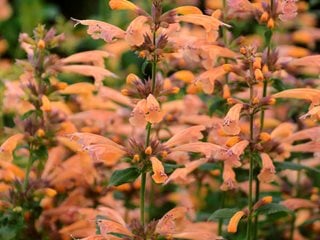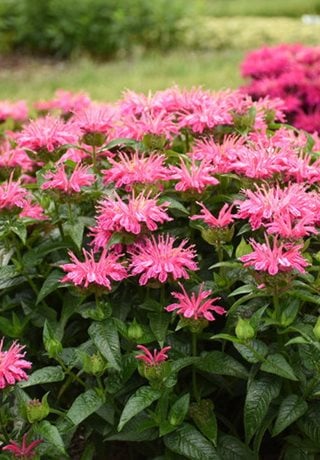HOW TO GROW AGASTACHE IN YOUR GARDEN
Attract pollinators to your yard with wildlife-friendly agastache plants Published 3/11/2022 | Updated 3/28/25Agastache is a carefree herbaceous perennial, with tubular flowers that are highly attractive to bees, butterflies, and hummingbirds. Also known as anise hyssop, licorice mint, giant hyssop, or hummingbird mint, the flower spikes come in a wide range of colors, from white to purple. This member of the mint family produces aromatic foliage that can be used to make tea, potpourris, or for other culinary uses.
Native to North America, South America, and parts of Asia, Agastache thrives in heat and is tolerant of drought and poor soils. This versatile easy-to-grow plant blooms for weeks from summer into fall, and is suitable for xeriscapes, waterwise borders, and rock gardens. Growing agastache and using it in the landscape is simple. Here’s how:
On this page: Basics | Planting | Care | Varieties | Design Tips
AGASTACHE BASICS
Botanical name:
Agastache spp.
Zones:
3-10, depending on the variety (most varieties 5-9)
Habit:
Upright, bushy or spreading habit
Height/Spread:
1 to 6 feet tall, 1 to 3 feet wide
Exposure:
Full sun
Bloom Time:
Summer to early fall
Flowers:
Dense clusters of tubular flowers occur in colors of blue, purple, apricot, coral, orange, red, yellow, or white.
Foliage:
Plants have sturdy square stems that are characteristic of the mint family. Leaves can be heart-shaped or pointed with serrated edges, or thin and lance-shaped, occurring in colors of green, grey-green, or gold. The foliage has an anise or licorice scent when crushed. Seeds are a source of food for songbirds.
Is agastache poisonous?
Agastache is not considered toxic to pets and children, though ingesting any type of plant may cause mild stomach distress for pets.
Is agastache deer resistant?
Agastache is considered deer-resistant, though any plant may be susceptible to deer browsing if other food sources are scarce.
HOW TO PLANT AGASTACHE
When to plant:
Plant agastache in cooler months of spring or fall to avoid shock.
Where to plant:
Choose a warm sunny site with lean, well-draining soil.
How to plant:
Loosen soil in planting area and lightly amend with compost or other organic matter. If plants are pot-bound, gently tease out the roots. Dig a hole slightly larger than the root ball and place in the planting hole so the top of the root ball is level with the surrounding soil. Fill in the hole with soil, tamp down gently to remove air pockets, and water thoroughly. Water plants regularly until established.
Soil:
Agastache prefers lean soil that drains well, with a pH between 6.0 and 8.0. Don’t over-amend the native soil, as this can cause fewer flowers and weakened growth. In areas with cool wet winters, mulch with gravel to help prevent roots from freezing and rotting.
For containers:
Make sure pots have adequate drainage holes. Use a high quality all-purpose potting soil that drains well.
AGASTACHE CARE
Temperature and humidity:
This heat lover thrives in warmer weather and prefers dry conditions. Too much humidity can cause root rot, fungal disease, and yellowing of leaves. Provide good air circulation.
Water:
Although drought tolerant once established, water agastache regularly until healthy roots develop, then occasionally as needed. Overwatering can cause crown or root rot. In cooler wetter regions, keep soil dry around the base of plants in winter.
Amendments and fertilizer:
Agastache prefers lean conditions, needing little or no supplemental fertilizer. If desired, apply a thin layer of compost in spring.
Pruning and deadheading:
Agastache is an herbaceous perennial plant that will die back to the ground in fall. Cut back dormant stems to half their height to protect from winter winds. In late winter or early spring, cut the remaining stems back to the ground before plants break dormancy. Pinch new growth to promote more branching and a bushier habit. Deadhead spent flowers to promote rebloom.
Dividing:
To rejuvenate older plants, divide in spring every 3 to 5 years. (Learn more on how & when to divide perennials.)
Pests and diseases:
When planted in the right conditions, agastache has few pests or diseases. Pests can include spider mites, thrips, aphids, whitefly or slugs. Diseases, which are primarily due to wet soil or excessive humidity, include powdery mildew, rust, botrytis, leaf spot, leaf blight, or root rot.
AGASTACHE VARIETIES
DESIGN TIPS
Agastache is a versatile perennial, with many uses in the landscape. Here are just a few ideas:
- Plant a compact variety in a rock garden in combination with creeping succulents, thyme, stonecrop, dianthus, ice plant (Delosperma), and blue fescue.
- Adorn a curbside strip with agastache and other long blooming, low water perennials such as lavender, catmint, yarrow, beardtongue (Penstemon) and fountain grass (Pennisetum).
- Place a large decorative ceramic container near a deck or patio and plant with a compact variety of agastache alongside other plants with similar cultural needs such as lantana, gazania, African daisy (Osteospermum), ‘Angelina’ sedum, or New Zealand flax (Phormium).
- Naturalize in a meadow setting with other flowering natives such as black-eyed Susan, gayfeather (Liatris), purple coneflower (Echinacea), salvia, milkweed, and asters to attract hummingbirds, butterflies and insect pollinators.
- Plant an herb garden with anise hyssop (Agastache foeniculum) and some of your culinary favorites such as oregano, marjoram, sage, rosemary, thyme, mint, and lavender.
- Mass along a slope, alternating groupings of other long blooming drought-tolerant plants such as lavender, Russian sage (Perovskia), salvia, sea holly (Eryngium) or tickseed (Coreopsis).
- For late season color, plant agastache alongside asters, goldenrod, salvia, Joe pye weed, silvergrass (Miscanthus), stonecrop (Sedum), and little bluestem (Schizachyrium scoparium).
Related:
Native Plants
20 Top Perennials for Pots
20 Drought-Tolerant Plants for Your Garden
Summer Flowers for Your Garden














